Experimental Research of Symmetrical Airfoil Piezoelectric Energy Harvester Excited by Vortex-Induced Flutter Coupling
Abstract
1. Introduction
2. Design of the VFPEH
3. Experimental Setup
4. Experimental Results and Discussion
4.1. Influence of the Key Parameters of the VFPEH on Its Output Performance
4.1.1. Diameter of Cylindrical Bluff Body
4.1.2. Load Resistance
4.2. Experimental Study of the Output Performance of the Energy Harvester
4.2.1. Output Performance of VEH-30
4.2.2. Output Performance of FEH
4.2.3. Output Performance of VFPEH-30
4.3. Analysis of Coupling Effect of Vortex-Induced Flutter Excitation
5. Conclusions
Author Contributions
Funding
Institutional Review Board Statement
Informed Consent Statement
Data Availability Statement
Conflicts of Interest
References
- Sezer, N.; Koç, M. A Comprehensive Review on the State-of-the-art of Piezoelectric Energy Harvesting. Nano Energy 2021, 80, 105567. [Google Scholar]
- Yang, Z.B.; Zhou, S.X.; Jean, Z.; Daniel, I. High-Performance Piezoelectric Energy Harvesters and Their Applications. Joule 2018, 2, 642–697. [Google Scholar]
- Deterre, M.; Lefeuvre, E.; Zhu, Y.; Woytasik, M.; Boutaud, B.; Molin, R.D. Micro Blood Pressure Energy Harvester for Intracardiac Pacemaker. J. Microelectromech. Syst. 2014, 23, 651–660. [Google Scholar] [CrossRef]
- Hossain, I.Z.; Khan, A.; Hossain, G. A Piezoelectric Smart Textile for Energy Harvesting and Wearable Self-Powered Sensors. Energies 2022, 15, 5541. [Google Scholar] [CrossRef]
- Wang, H.; Jasim, A.; Chen, X. Energy Harvesting Technologies in Roadways and Bridges for Different Applications—A Comprehensive Review. Energy 2018, 212, 1083–1094. [Google Scholar]
- Su, Y.; Zhang, K.; Gong, Q. Theoretical and experimental study of an elect-romagnetic vibration energy harvester. Ferroelectrics 2019, 551, 69–87. [Google Scholar] [CrossRef]
- Kamenar, E.; Zelenika, S.; Blažević, D.; Maćešić, S.; Gregov, G.; Marković, K.; Glažar, V. Harvesting of River Flow Energy for Wireless Sensor Network Technology. Microsyst. Technol. Sens. Actuators Syst. Integr. 2015, 22, 1557–1574. [Google Scholar] [CrossRef]
- Evans, M.; Tang, L.; Tao, K.; Aw, K. Design and Optimisation of an Underfloor Energy Harvesting System. Sens. Actuators A Phys. 2019, 285, 613–622. [Google Scholar] [CrossRef]
- Lim, Y.Y.; Padilla, R.V.; Unger, A.; Barraza, R.; Thabet, A.M.; Izadgoshasb, I. A Self-tunable Wind Energy Harvester Utilising a Piezoelectric Cantilever Beam with Bluff Body under Transverse Galloping for Field Deployment. Energy Convers. Manag. 2021, 245, 114559. [Google Scholar] [CrossRef]
- Rojas, F.E.; Faroughi, S.; Abdelkefi, A.; Park, Y.H. Investigations on the Performance of Piezoelectric-flexoelectric Energy Harvesters. Appl. Energy 2021, 288, 116611. [Google Scholar] [CrossRef]
- Imbaquingo, C.; Bahl, C.; Insinga, A.R.; Bjørk, R. A Two-dimensional Electromagnetic Vibration Energy Harvester with Variable Stiffness. Appl. Energy 2022, 325, 119650. [Google Scholar] [CrossRef]
- Zhang, Y.; Wang, T.; Luo, A.; Hu, Y.; Li, X.; Wang, F. Micro electrostatic energy harvester with both broad bandwidth and high normalized power density. Appl. Energy 2018, 212, 362–371. [Google Scholar] [CrossRef]
- Kumar, S.; Singh, D.; Kumar, R.; Jain, S.C. No-Wear Vibration Energy Harvester Based on a Triboelectric Mechanism. J. Electron. Mater. 2021, 50, 7057–7070. [Google Scholar] [CrossRef]
- Zhao, X.; Shang, Z.; Luo, G.; Deng, L. A Vibration Energy Harvester Using AlN Piezoelectric Cantilever Array. Microelectron. Eng. 2015, 142, 47–51. [Google Scholar] [CrossRef]
- Lai, Z.; Wang, S.; Zhu, L.; Zhang, G.; Wang, J.; Yang, K.; Yurchenko, D. A Hybrid Piezo-dielectric Wind Energy Harvester for High-performance Vortex-induced Vibration Energy Harvesting. Mech. Syst. Signal Process. 2021, 150, 107212. [Google Scholar] [CrossRef]
- Mehdipour, I.; Madaro, F.; Rizzi, F.; de Vittorio, M. Comprehensive Experimental Study on Bluff Body Shapes for Vortex-induced Vibration Piezoelectric Energy Harvesting Mechanisms. Energy Convers. Manag. X 2022, 13, 100174. [Google Scholar] [CrossRef]
- Liu, J.; Bao, B.; Chen, J.; Wu, Y.; Wang, Q. Passively Adaptive Wind Energy Harvester Featuring a Double-airfoil Bluff Body with Adjustable Attack Angles. Mech. Syst. Signal Process. 2023, 185, 109814. [Google Scholar] [CrossRef]
- Stefano, O.; Boccalero, G.; Mazzino, A.; Boragno, C. Fluttering Conditions of an Energy Harvester for Autonomous Powering. Energy 2017, 105, 530–538. [Google Scholar]
- Ming, X.; Wang, B.; Li, X.; Zhou, S.; Yurchenko, D. Dynamic Response Mechanism of the Galloping Energy Harvester under Fluctuating Wind Conditions. Mech. Syst. Signal Process. 2022, 166, 108410. [Google Scholar]
- Yili, H.; Yang, B.; Chen, X.; Wang, X.; Liu, J. Modeling and Experimental Study of a Piezoelectric Energy Harvester from Vortex Shedding-induced Vibration. Energy Convers. Manag. 2018, 162, 145–158. [Google Scholar]
- Dai, H.L.; Abdelkefi, A.; Yang, Y.; Wang, L. Orientation of Bluff Body for Designing Efficient Energy Harvesters from Vortex-induced Vibrations. Phys. Lett. 2016, 108, 53902. [Google Scholar] [CrossRef]
- Shengxi, Z.; Wang, J. Dual Serial Vortex-induced Energy Harvesting System for Enhanced Energy Harvesting. AIP Adv. 2018, 8, 075221. [Google Scholar]
- Akaydin, H.D.; Elvin, N.; Andreopoulos, Y. The Performance of a Self-excited Fluidic Energy Harvester. Smart Mater. Struct. 2012, 21, 025007. [Google Scholar] [CrossRef]
- Junlei, W.; Ran, J.; Zhang, Z. Energy Harvester Based on the Synchronization Phenomenon of a Circular Cylinder. Math. Probl. Eng. 2014, 2014, 1–9. [Google Scholar]
- Weipeng, S.; Zhao, D.; Tan, T.; Yan, Z.; Guo, P.; Luo, X. Low Velocity Water Flow Energy Harvesting Using Vortex Induced Vibration and Galloping. Energy 2019, 251, 113392. [Google Scholar]
- Weinstein, A.L.; Cacan, M.R.; So, P.M.; Wright, P.K. Vortex Shedding Induced Energy Harvesting from Piezoelectric Materials in Heating, Ventilation and Air Conditioning Flows. Smart Mater. Struct. 2012, 21, 45003. [Google Scholar] [CrossRef]
- Xia, L.; Li, Z.; Bi, C.; Liu, B.; Su, Y. Study on Wind Energy Harvesting Effect of a Vehicle-Mounted Piezo-Electromagnetic Hybrid Energy Harvester. IEEE Access 2020, 8, 167631–167646. [Google Scholar]
- Fei, F.; Zhou, S.; Mai, J.D.; Li, W.J. Development of an Indoor Airflow Energy Harvesting System for Building Environment Monitoring. Energies 2014, 7, 2985–3003. [Google Scholar] [CrossRef]
- Soon-Duck, K. A T-shaped Piezoelectric Cantilever for Fluid Energy Harvesting. Phys. Lett. 2010, 97, 164102. [Google Scholar]
- Dunnmon, J.A.; Stanton, S.C.; Mann, B.P.; Dowell, E.H. Power Extraction from Aeroelastic Limit Cycle Oscillations. J. Fluids Struct. 2011, 27, 1182–1198. [Google Scholar] [CrossRef]
- Bryant, M.; Wolff, E.; Garcia, E. Parametric design study of an aeroelastic flutter energy harvester. Proc. SPIE 2011, 7977, 1–11. [Google Scholar]
- Ngan, T.; Ghayesh, M.H.; Arjomandi, M. Ambient Vibration Energy Harvesters: A Review on Nonlinear Techniques for Performance Enhancement. Int. J. Eng. Sci. 2018, 127, 162–185. [Google Scholar]
- Mahmoudi, S.; Kacem, N.; Bouhaddi, N. Enhancement of the Performance of a Hybrid Nonlinear Vibration Energy Harvester Based on Piezoelectric and Electromagnetic Transductions. Smart Mater. Struct. 2014, 23, 75024. [Google Scholar] [CrossRef]
- Masood, A.M.; Khan, F.U. Review of Vibration-based Electromagnetic–piezoelectric Hybrid Energy Harvesters. Int. J. Energy Res. 2021, 45, 5058–5097. [Google Scholar]
- Kui, L.; Yang, Z.; Gu, Y.; He, S.; Zhou, S. Nonlinear Magnetic-coupled Flutter-based Aeroelastic Energy Harvester: Modeling, Simulation and Experimental Verification. Smart Mater. Struct. 2018, 28, 15020. [Google Scholar]
- Rawnak, H.; Yuce, M.R. A Wearable Energy Harvester Unit Using Piezoelectric-electromagnetic Hybrid Technique. Sens. Actuators A Phys. 2017, 257, 198–207. [Google Scholar]
- Zhongjie, L.; Al-Riyami, M.; Bahadur, I.; Ouakad, H. There Is Plenty of Room inside a Bluff Body: A Hybrid Piezoelectric and Electromagnetic Wind Energy Harvester. Energies 2022, 15, 6097. [Google Scholar]
- Junlei, W.; Gu, S.; Zhang, C.; Hu, G.; Chen, G.; Yang, K.; Li, H.; Lai, Y.; Litak, G.; Yurchenko, D. Hybrid Wind Energy Scavenging by Coupling Vortex-induced Vibrations and Galloping. Energy Convers. Manag. 2020, 213, 112835. [Google Scholar]
- Xiaobiao, S.; Tian, H.; Cao, H.; Xie, T. Enhancing Performance of a Piezoelectric Energy Harvester System for Concurrent Flutter and Vortex -induced Vibration. Energies 2020, 13, 3101. [Google Scholar]
- Atrah, A.B.; Ab-Rahman, M.S.; Salleh, H.; Nuawi, M.Z.; Nor, M.J.M.; Jamaludin, N.B. Karman Vortex Creation Using Cylinder for Flutter Energy Harvester Device. Micromachines 2017, 8, 227. [Google Scholar] [CrossRef]
- Chengwei, H.; Shan, X.; Zhang, L.; Song, R.; Yang, Z. Design and Modeling of a Magnetic-Coupling Monostable Piezoelectric Energy Harvester Under Vortex-Induced Vibration. IEEE Access 2020, 8, 108913–108927. [Google Scholar]
- Zhiyuan, L.; Li, X.; Liu, B.; Wang, J. Influence of Vehicle Body Vibration Induced by Road Excitation on the Performance of a Vehicle-mounted Piezoelectric-electromagnetic Hybrid Energy Harvester. Smart Mater. Struct. 2021, 30, 55019. [Google Scholar]
- Miguel, P.; Doaré, O.; Michelin, S. Influence and Optimization of the Electrodes Position in a Piezoelectric Energy Harvesting Flag. J. Sound Vib. 2015, 346, 200–215. [Google Scholar]
- Nishigaki, T. Development of a piezoelectric polymer energy harvestin-g flag. Act. Passiv. Smart Struct. Integr. Syst. 2013, 8688, 1–7. [Google Scholar]
- Sousa, V.C.; de M. Anicézio, M.; De Marqui, C., Jr.; Erturk, A. Enhanced Aeroelastic Energy Harvesting by Exploiting Combined Nonlinearities: Theory and Experiment. Smart Mater. Struct. 2011, 20, 094007. [Google Scholar] [CrossRef]
- Abdelkefi, A.; Nayfeh, A.H.; Hajj, M.R. Modeling and Analysis of Piezoaeroelastic Energy Harvesters. Nonlinear Dyn. 2011, 67, 925–939. [Google Scholar] [CrossRef]
- Dias, J.A.C.; De Marqui Jr, C.; Erturk, A. Hybrid Piezoelectric-inductive Flow Energy Harvesting and Dimensionless Electroaeroelastic Analysis for Scaling. Phys. Lett. 2013, 102, 44101. [Google Scholar] [CrossRef]


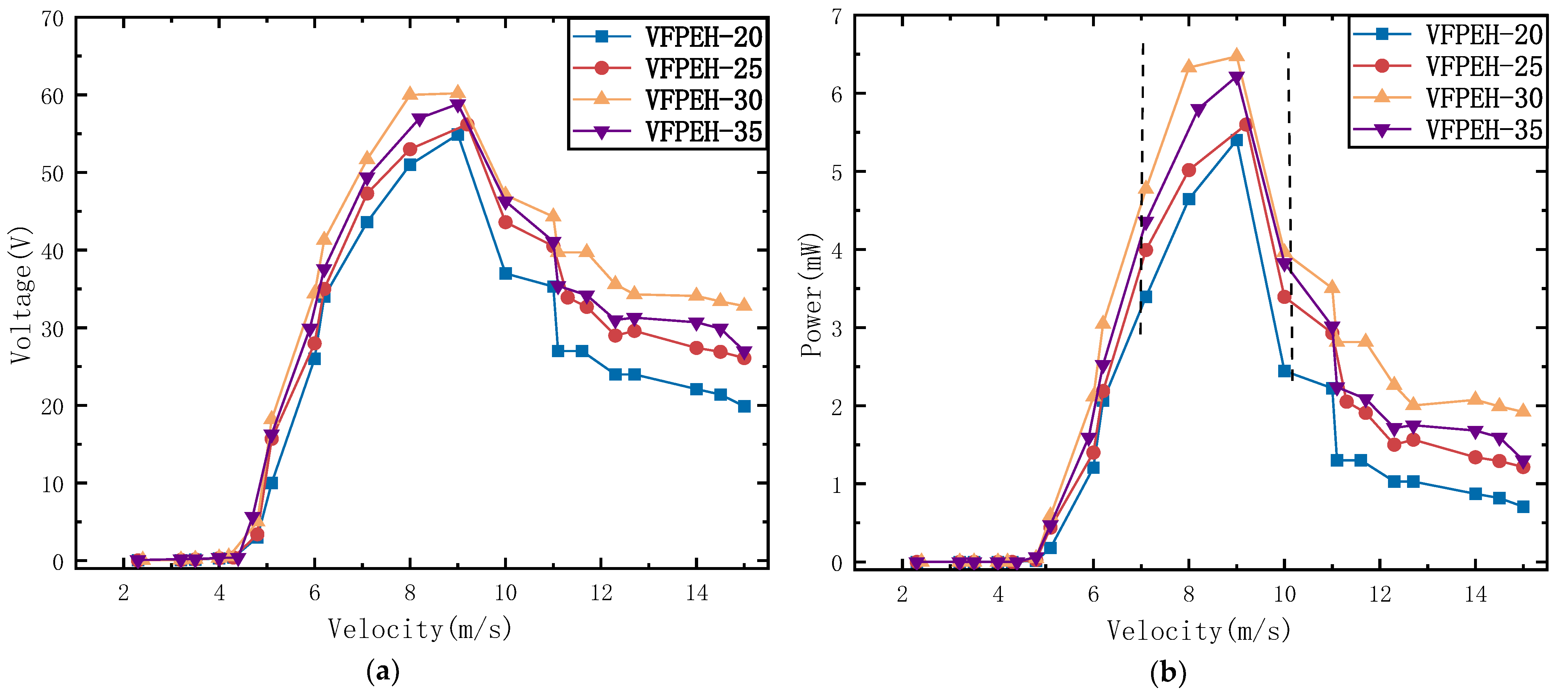
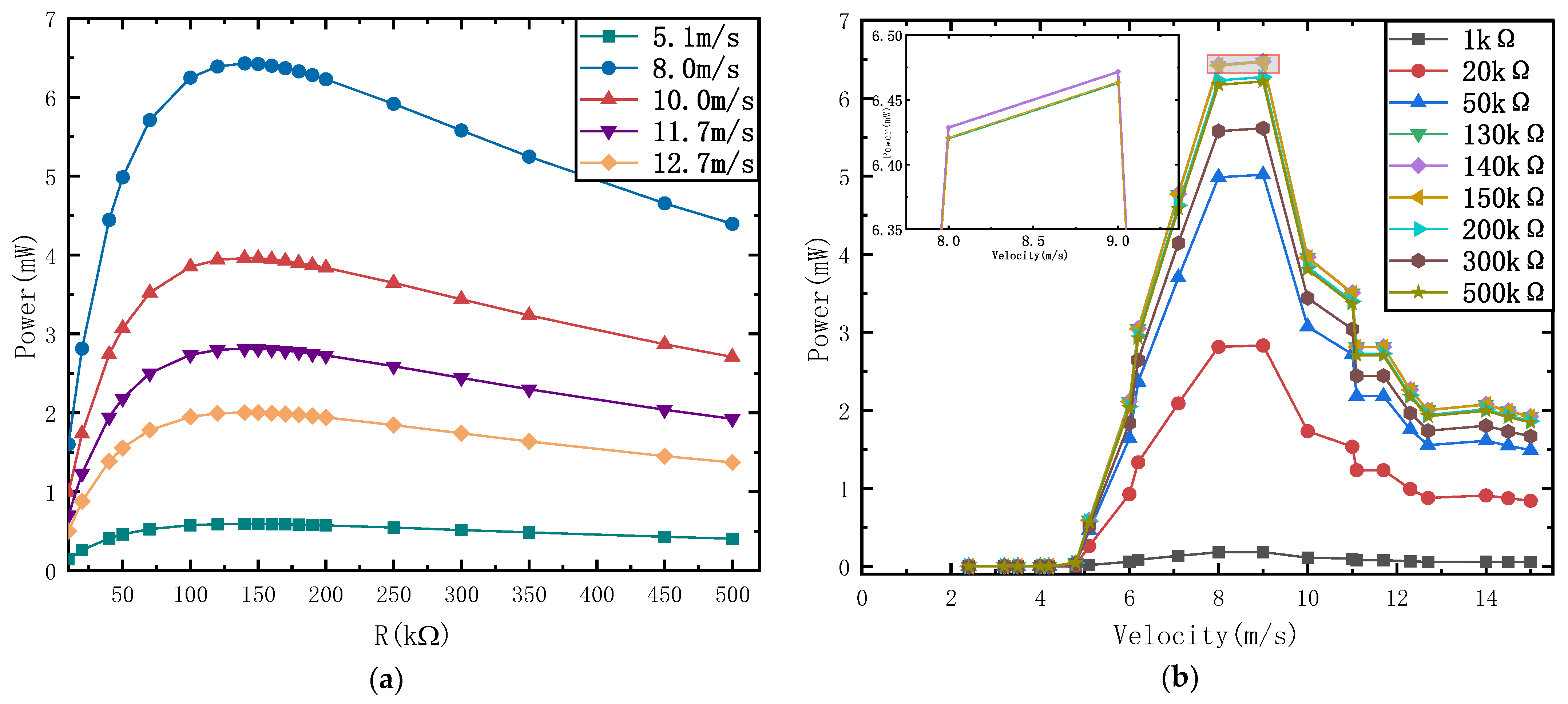
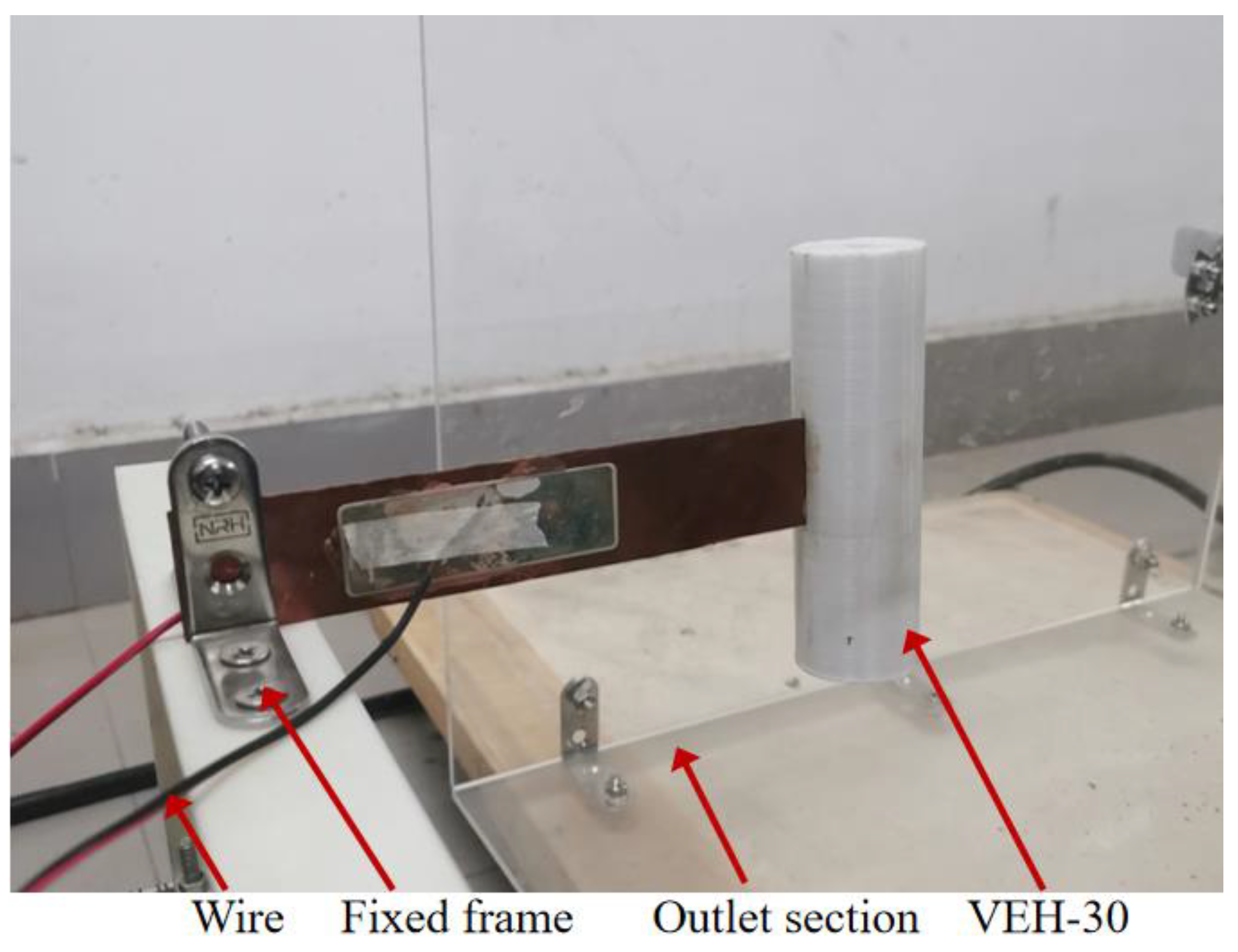

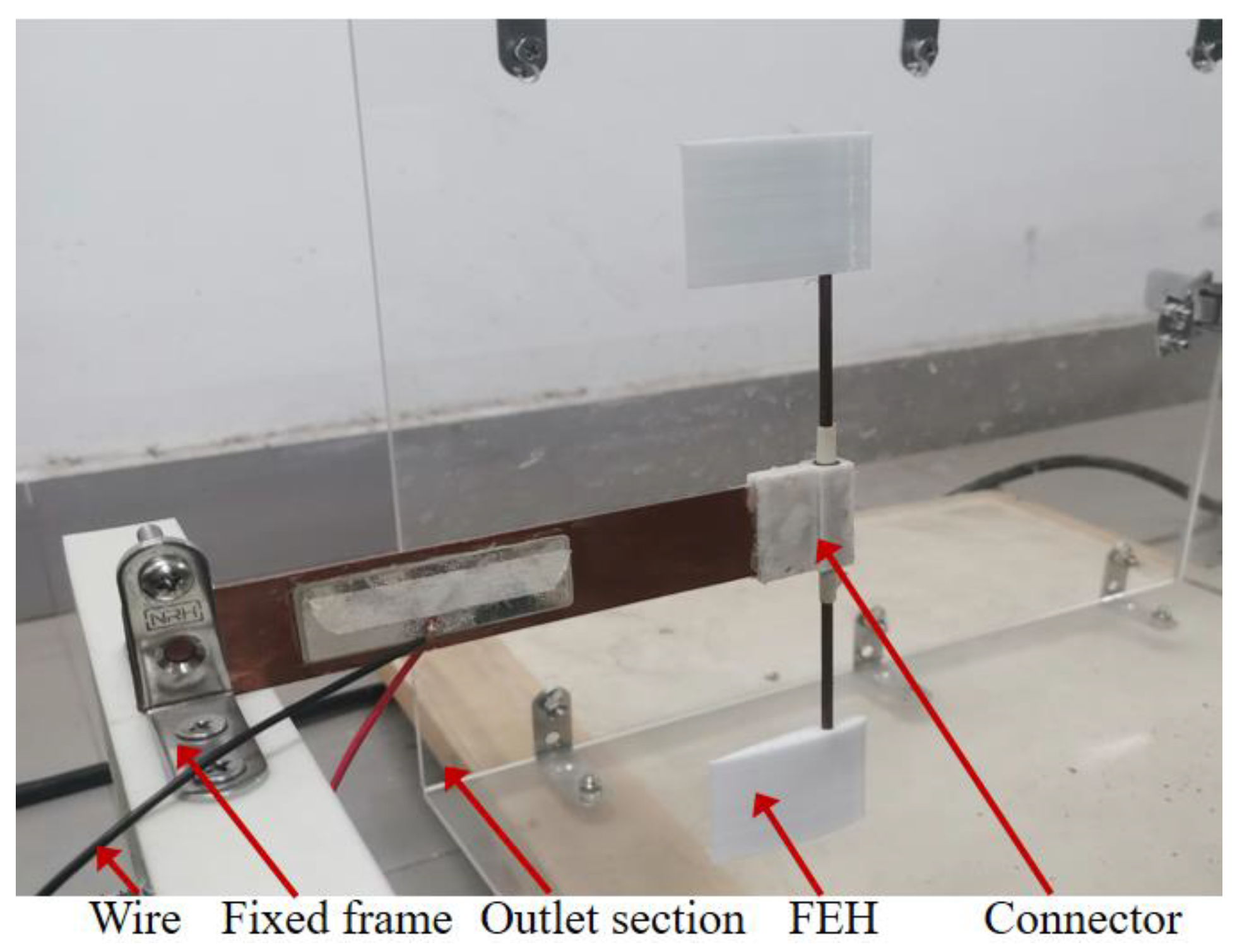


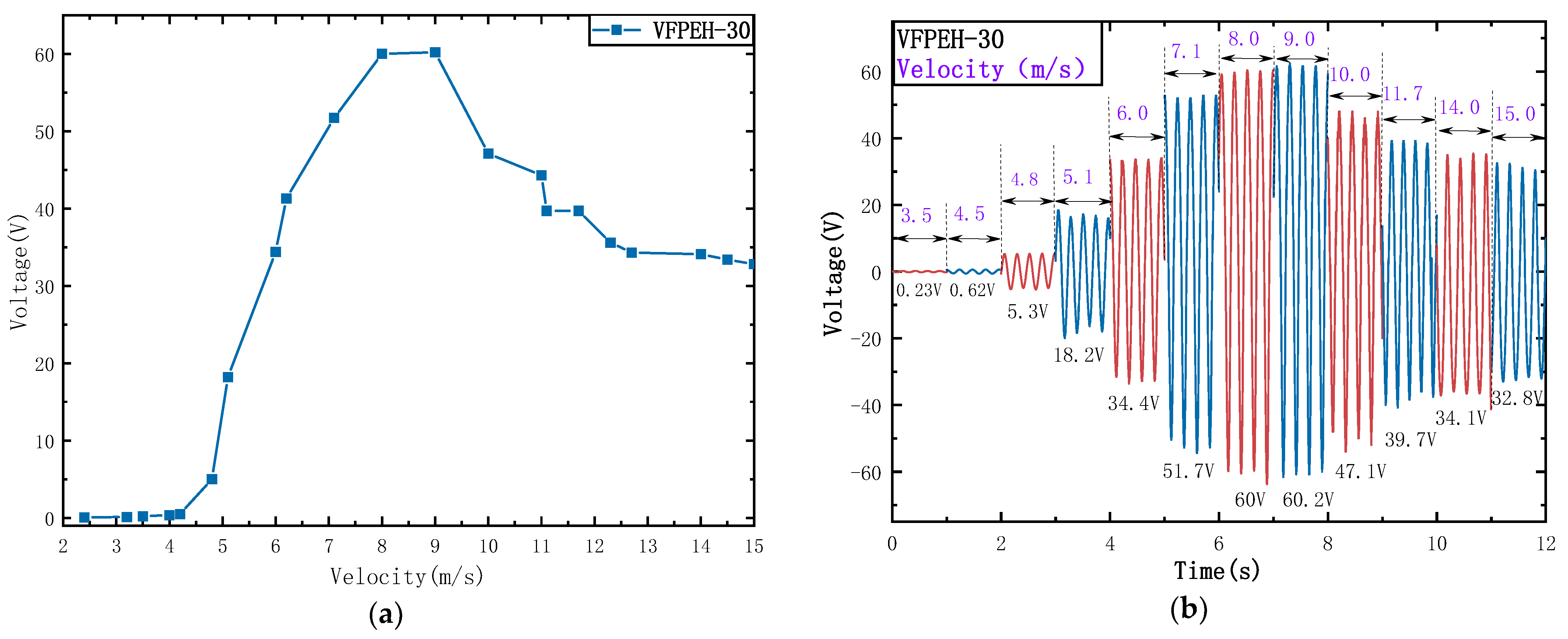

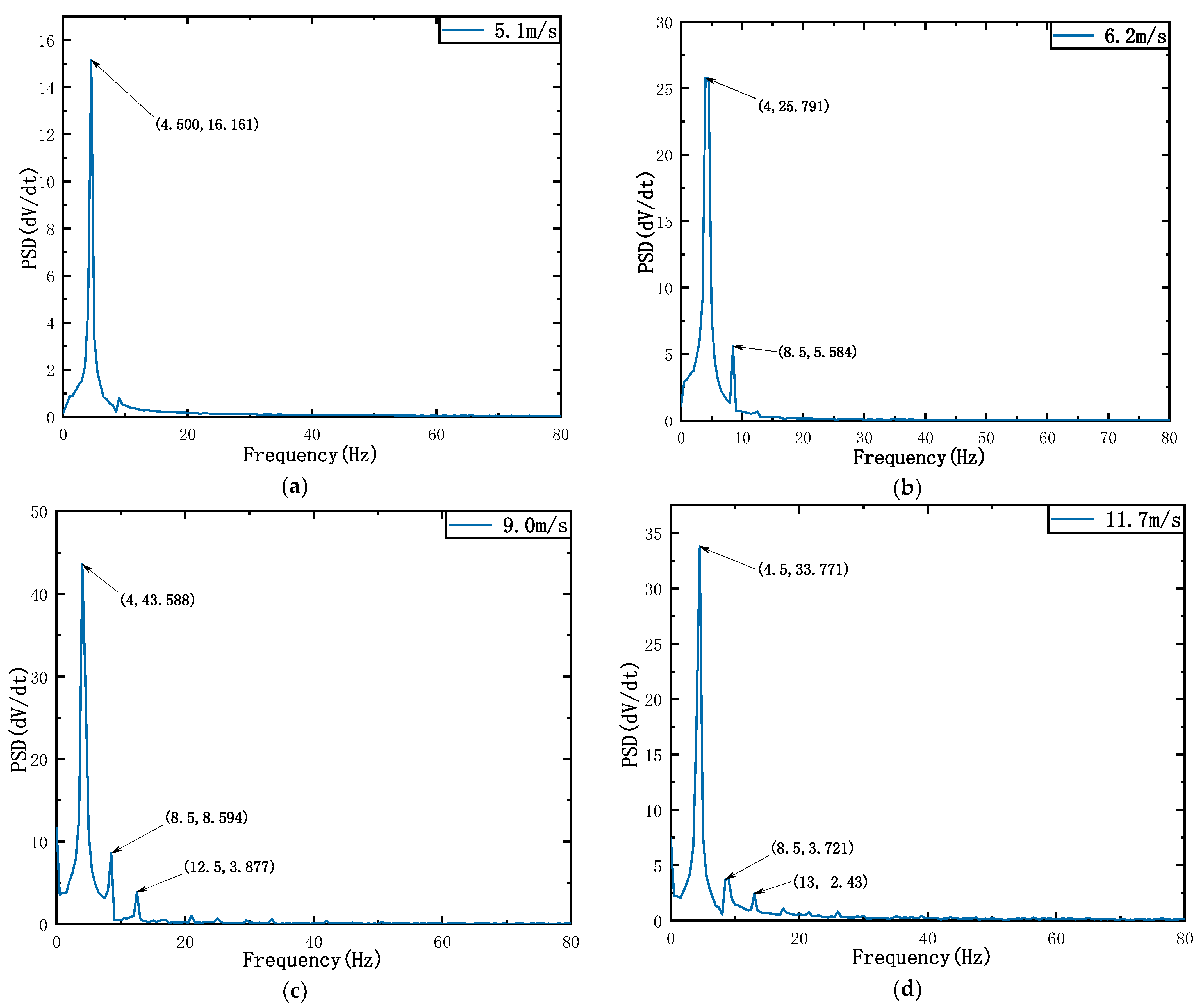

| Properties | Substrates | Piezoelectric Sheets | Bluff Body | Shaft | Bearings |
|---|---|---|---|---|---|
| Materials | Copper alloy | PZT-5H | PLA | Copper | Bearing steel |
| Density (kg/m3) | 8900 | 7500 | 1250 | 8700 | 7810 |
| Young’s modulus (GPa) | 105 | 66 | 3.5 | 119 | - |
| Poisson’s ratio | 0.35 | 0.3 | - | 0.32 | - |
| Length (mm) | 140 | 60 | 100 | 150 | - |
| Width/Diameter (mm) | 26 | 20 | 20–35 | 0.3 | 6 |
| Thickness (mm) | 0.4 | 0.2 | - | - | 2.5 |
| Properties | Airfoil |
|---|---|
| Materials | PLA |
| Density (kg/m3) | 1250 |
| Young’s modulus (GPa) | 3.5 |
| VFPEH captive energy mass (g) | 72.4 |
| Cantilever beam mass (substrate and PZT) (g) | 20.1 |
| airfoil mass (g) | 8.4 |
| Connecting shaft mass (shaft and bearing) (g) | 9.9 |
| Cylindrical mass (g) | 50.5 |
| Span (mm) | 50 |
| Half chord (mm) | 18 |
| Airfoil axis position (mm) | 15 |
| Harvester Type | VFPEH-20 | VFPEH-25 | VFPEH-30 | VFPEH-35 |
|---|---|---|---|---|
| Diameter (mm) | 20 | 25 | 30 | 35 |
| Maximum output voltage Umax (V) | 54.9 | 56.2 | 60.2 | 58.8 |
| maximum output power Pmax (mW) | 5.40 | 5.60 | 6.47 | 6.22 |
| Properties | Substrates | Piezoelectric Sheets | Bluff Body |
|---|---|---|---|
| Materials | Copper alloy | PZT-5H | PLA |
| Density (kg/m3) | 8900 | 7500 | 1250 |
| Young’s modulus (GPa) | 105 | 66 | 3.5 |
| Poisson’s ratio | 0.35 | 0.3 | - |
| Length (mm) | 140 | 60 | 100 |
| Width/Diameter (mm) | 26 | 20 | 30 |
| Thickness (mm) | 0.4 | 0.2 | - |
| Properties | Substrates | Piezoelectric Sheets | Connector | Shaft | Bearings |
|---|---|---|---|---|---|
| Materials | Copper alloy | PZT-5H | PLA | Copper | Bearing steel |
| Density (kg/m3) | 8900 | 7500 | 1250 | 8700 | 7810 |
| Young’s modulus (GPa) | 105 | 66 | 3.5 | 119 | - |
| Poisson’s ratio | 0.35 | 0.3 | - | 0.32 | - |
| Length (mm) | 140 | 60 | - | 150 | - |
| Width/Diameter (mm) | 26 | 20 | - | 0.3 | 6 |
| Thickness (mm) | 0.4 | 0.2 | - | - | 2.5 |
| V0 (m/s) | Vmax (m/s) | Umax (V) | Pmax (W) | |
|---|---|---|---|---|
| VEH-30 | 7.1 | 12.5 | 3.59 | 0.05 |
| FEH | 8.5 | 14.5 | 9.53 | 0.26 |
| VFPEH-30 | 4.8 | 9.0 | 60.20 | 6.47 |
Publisher’s Note: MDPI stays neutral with regard to jurisdictional claims in published maps and institutional affiliations. |
© 2022 by the authors. Licensee MDPI, Basel, Switzerland. This article is an open access article distributed under the terms and conditions of the Creative Commons Attribution (CC BY) license (https://creativecommons.org/licenses/by/4.0/).
Share and Cite
Li, X.; Wang, X.; Tian, H.; Wang, C.; Liu, B. Experimental Research of Symmetrical Airfoil Piezoelectric Energy Harvester Excited by Vortex-Induced Flutter Coupling. Appl. Sci. 2022, 12, 12514. https://doi.org/10.3390/app122412514
Li X, Wang X, Tian H, Wang C, Liu B. Experimental Research of Symmetrical Airfoil Piezoelectric Energy Harvester Excited by Vortex-Induced Flutter Coupling. Applied Sciences. 2022; 12(24):12514. https://doi.org/10.3390/app122412514
Chicago/Turabian StyleLi, Xia, Xiaoxiao Wang, Haigang Tian, Chengming Wang, and Benxue Liu. 2022. "Experimental Research of Symmetrical Airfoil Piezoelectric Energy Harvester Excited by Vortex-Induced Flutter Coupling" Applied Sciences 12, no. 24: 12514. https://doi.org/10.3390/app122412514
APA StyleLi, X., Wang, X., Tian, H., Wang, C., & Liu, B. (2022). Experimental Research of Symmetrical Airfoil Piezoelectric Energy Harvester Excited by Vortex-Induced Flutter Coupling. Applied Sciences, 12(24), 12514. https://doi.org/10.3390/app122412514






